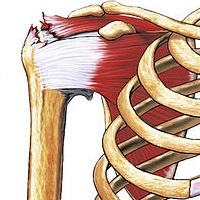
Photo from wikipedia
Objective To evaluate the postoperative clinical outcomes of the arthroscopic repair of rotator cuff injuries using a suture configuration we have developed based on a modification of the Suture Bridge… Click to show full abstract
Objective To evaluate the postoperative clinical outcomes of the arthroscopic repair of rotator cuff injuries using a suture configuration we have developed based on a modification of the Suture Bridge (Arthrex, Naples, FL, United States). Methods A retrospective study with 28 male (41.2%) and 40 female (58.8%) subjects with a mean age of 60 years. All patients underwent rotator cuff repair with the modified Suture Bridge technique and follow-up for a minimum period of 18 months. The clinical assessment was performed using the University of California, Los Angeles (UCLA) Shoulder Score. Results The mean postoperative range of motion was of 134° (range: 110° to 140°) for elevation, 58° (range: 40° to 70°) for lateral rotation, and T10 (range: L4 to T7) for medial rotation. The mean increase was of 15° for elevation, 14° for lateral rotation, and 2 vertebral levels for medial rotation. The outcomes were excellent in 61 (83.6%) cases, good in 8 (10.9%), and regular in 4 cases (5.5%). Conclusion The modified Suture Bridge technique for the arthroscopic repair of rotator cuff injuries led to excellent or good postoperative clinical outcomes in most cases (69; 94.5%).
Journal Title: Revista Brasileira de Ortopedia
Year Published: 2022
Link to full text (if available)
Share on Social Media: Sign Up to like & get
recommendations!